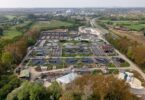A new £2.2 million wetlands project near Poole is set to boost the drive towards using natural methods to help protect the area around Europe’s largest natural harbour.
Wessex Water is building the first scheme of its type in the county of Dorset, ensuring stormwater can be treated sustainably before being released back into the Poole Harbour Catchment.
The project will be designed to ease the pressure on the pumping station, which handles local sewage, reducing the threat of pollution and flooding from the sewer network which can occur when the system is overwhelmed by heavy rain or the infiltration of groundwater.
The two-hectare wetland, which will feature three lagoons and a wet woodland containing a variety of native plants and trees to help the natural cleansing process, is being built on land next to Bulbury Lane Sewage Pumping Station, near the village of Lytchett Matravers, in spring 2025.
It follows previous projects in Gloucestershire and Somerset which have trialled sustainable treatment methods to remove contaminants like ammonia, suspended solids, phosphate and nitrate from water, while enhancing natural habitats and significantly boosting biodiversity.
The Post Green wetland will help to ease the pressure on the pumping station, which handles sewage from Lytchett Matravers, reducing the threat of pollution and flooding from the system that is significantly affected by groundwater infiltration.
Nearly 9,000 square metres of wetland will treat excess water that occurs when heavy rain overwhelms the sewers that can carry both foul sewage and rain runoff. After passing through the natural process to remove contaminants, the water will reach the Poole Harbour Catchment.
The four-stage process includes two wetland cells book-ended by a pond and a wet woodland. It’s the latest project in the company’s push to explore natural solutions to treat wastewater, an ambition that has already delivered encouraging results and attracted wider attention throughout the water industry and received the backing of local communities.
Europe’s largest natural harbour
Project manager Al Barlow said: “This will be the first constructed wetland in Dorset and it will help to tackle specific issues that have occurred at Lytchett Matravers, which has been suffering the effects of flooding and groundwater infiltration.
“We have worked hard to reline and seal the sewer system in this area but infiltration by groundwater, including from private sewerage systems, which subsequently cause the automatic operation of storm overflows, is a complex issue to resolve so we’ve looked at alternative ways to tackle it.
“The wetland will act as treatment to any water making its way into and through the wetland cells before discharging back into the Poole Harbour catchment.
“We want to increase the number of these wetlands projects by building confidence in their performance and finding the correct location for wetlands is key. Like this one, most are on private land and we work closely with the landowners on our plans.
Ruth Barden, Wessex Water’s Environmental Solutions Director, said: “We know some communities want wetlands to form part of the solution to these issues.
“That matches our determination to explore nature-based solutions where we can, instead of ‘grey’ infrastructure solutions that cause more impact on the environment, carry significant carbon implications and substantial costs and are extremely disruptive to communities.
“Wessex Water is an industry pioneer in identifying nature-based solutions, such as constructed wetlands, which are a key part of our mission to provide sustainable water and environmental services, protecting and enhancing habitats like rivers and natural wetlands and contributing to the wellbeing of our neighbourhoods.’’
The Lytchett Matravers wetland project is being built at Post Green Farm, on land purchased from Christopher and Clare Lees, who said: “This is a project we wholeheartedly support. It is good for biodiversity on our farm, good for downstream waterways and good for Poole Harbour.
“We’re delighted that Wessex Water has chosen this nature-based solution to help tackle the flooding issues in the area because as well as the natural treatment methods to help reduce nitrates and phosphates and store carbon, it will also create an important and beautiful new habitat for wildlife.
“I hope it will provide the template for wetlands throughout the Wessex Water area and beyond.’’
Construction of the project, the impact of which will be continuously monitored in the following months and years, is expected to be complete by the end of 2025.








